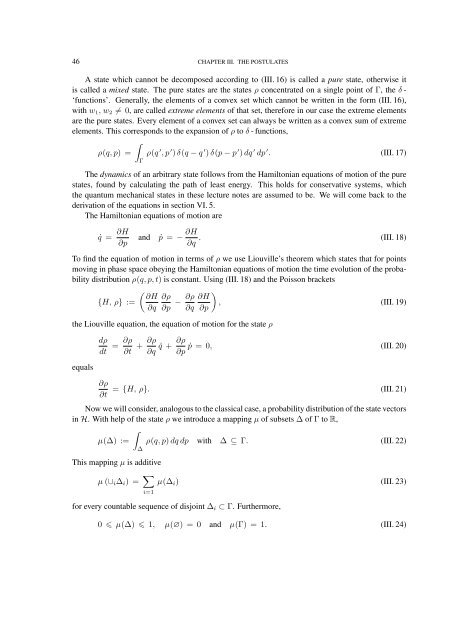FOUNDATIONS OF QUANTUM MECHANICS
FOUNDATIONS OF QUANTUM MECHANICS
FOUNDATIONS OF QUANTUM MECHANICS
Create successful ePaper yourself
Turn your PDF publications into a flip-book with our unique Google optimized e-Paper software.
46 CHAPTER III. THE POSTULATES<br />
A state which cannot be decomposed according to (III. 16) is called a pure state, otherwise it<br />
is called a mixed state. The pure states are the states ρ concentrated on a single point of Γ, the δ -<br />
‘functions’. Generally, the elements of a convex set which cannot be written in the form (III. 16),<br />
with w 1 , w 2 ≠ 0, are called extreme elements of that set, therefore in our case the extreme elements<br />
are the pure states. Every element of a convex set can always be written as a convex sum of extreme<br />
elements. This corresponds to the expansion of ρ to δ - functions,<br />
∫<br />
ρ(q, p) = ρ(q ′ , p ′ ) δ(q − q ′ ) δ(p − p ′ ) dq ′ dp ′ . (III. 17)<br />
Γ<br />
The dynamics of an arbitrary state follows from the Hamiltonian equations of motion of the pure<br />
states, found by calculating the path of least energy. This holds for conservative systems, which<br />
the quantum mechanical states in these lecture notes are assumed to be. We will come back to the<br />
derivation of the equations in section VI. 5.<br />
The Hamiltonian equations of motion are<br />
˙q = ∂H<br />
∂p<br />
and<br />
ṗ = − ∂H . (III. 18)<br />
∂q<br />
To find the equation of motion in terms of ρ we use Liouville’s theorem which states that for points<br />
moving in phase space obeying the Hamiltonian equations of motion the time evolution of the probability<br />
distribution ρ(q, p, t) is constant. Using (III. 18) and the Poisson brackets<br />
{H, ρ} :=<br />
( ∂H<br />
∂q<br />
∂ρ<br />
∂p − ∂ρ<br />
∂q<br />
∂H<br />
∂p<br />
the Liouville equation, the equation of motion for the state ρ<br />
)<br />
, (III. 19)<br />
equals<br />
dρ<br />
dt = ∂ρ<br />
∂t + ∂ρ<br />
∂q<br />
∂ρ ˙q + ṗ = 0, (III. 20)<br />
∂p<br />
∂ρ<br />
∂t<br />
= {H, ρ}. (III. 21)<br />
Now we will consider, analogous to the classical case, a probability distribution of the state vectors<br />
in H. With help of the state ρ we introduce a mapping µ of subsets ∆ of Γ to R,<br />
∫<br />
µ(∆) := ρ(q, p) dq dp with ∆ ⊆ Γ. (III. 22)<br />
∆<br />
This mapping µ is additive<br />
µ (∪ i ∆ i ) = ∑ i=1<br />
µ(∆ i ) (III. 23)<br />
for every countable sequence of disjoint ∆ i ⊂ Γ. Furthermore,<br />
0 µ(∆) 1, µ(∅) = 0 and µ(Γ) = 1. (III. 24)
















